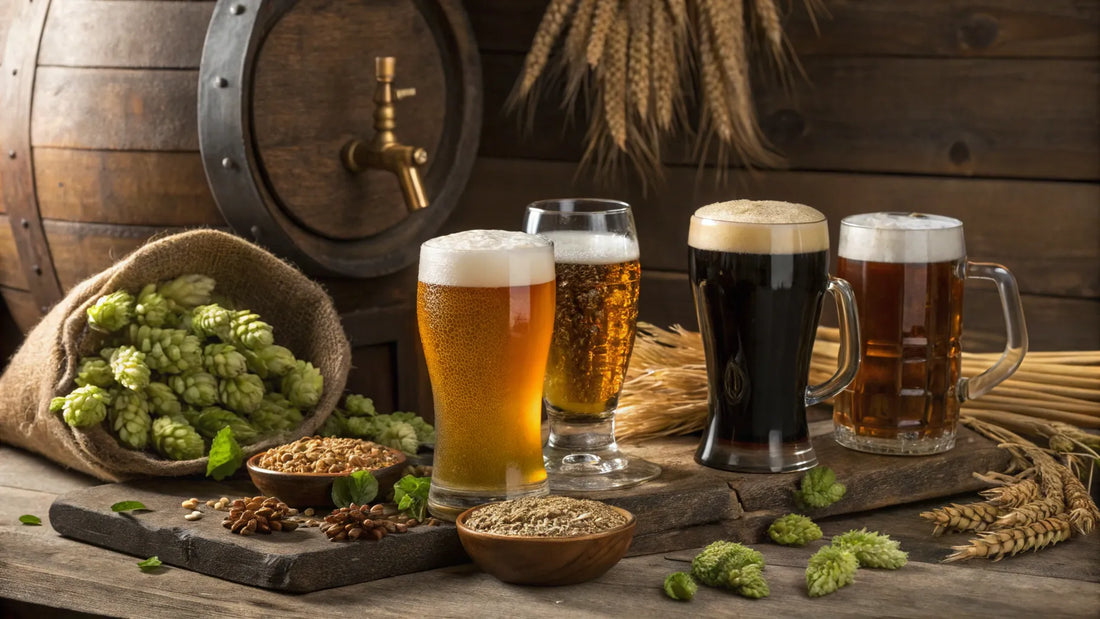Lager: More than just a Beer Style

Welcome to an in-depth exploration of lager, a versatile family of beers that is often misunderstood. In this blog, we dive into the rich history, varieties, and the unique characteristics that distinguish lager from other beer styles. Let's discover together why you might enjoy lager much more than you thought.
Introduction 🍺
Welcome to the world of lager! This is more than just a beer style; it is a family of beers that offers diversity and complexity. From fresh and light variants to rich and dark options, lager has something for everyone. Let's explore this fascinating world together.
What is Lager?
Lager is not just a style, it is a family of styles. It is characterized by the use of bottom-fermenting yeast, which ferments at lower temperatures. This results in a clear, clean taste. The fermentation at lower temperatures allows the flavors to develop subtly and minimizes unwanted off-flavors.
An Important Disclaimer
"Before we continue, it is crucial to understand that not all lagers are the same. The term 'lager' is often misused to describe various beers. This can lead to the misconception that you do not like lager, while you may just not like a specific style. It is important to be open to the diverse flavors that exist within the lager family."
Beer Tasting: The First Taste Experience 🍻
At a beer tasting, it's all about discovering flavors. Start with a light pilsner and let your senses be stimulated. Take a sip and notice how crisp and refreshing it is. Then try a more complex lager, like a Helles, and discover the subtle sweetness and floral aroma. The varieties are endless!
Lager Styles: An Overview 🍺
- Pilsner: One of the most popular lagers in the world, known for its clarity and fresh taste.
- Helles: A German lager that is slightly sweeter and less bitter than a pilsner.
- Dark: A dark lager with rich, roasted flavors.
- Maertzen: Traditionally brewed for Oktoberfest, full of malty sweetness.
- Kellerbier: An unfiltered lager with a rich, yeasty flavor.
Dark Lagers: An Exploration 🍺
Dark lagers are a hidden treasure within the lager family. These beers often have a full-bodied, roasted flavor with notes of coffee and chocolate. They are perfect for those seeking a more complex beer experience. Try a Dunkel or a Schwarzbier for a rich, satisfying taste.
The Italian Pilsner: A Unique Twist 🇮🇹
The Italian Pilsner is an exciting variant that gives the traditional pilsner a fresh twist. With a rich malt base and an abundance of German hops, this style offers a unique balance between bitterness and aroma. It is an excellent choice for lovers of both pilsners and hoppy beers.
Why People Say 'I Don't Like Lower' ❓
The statement 'I don't like lager' often stems from previous experiences with inferior beers. Many people associate lager with the large commercial brands that often have a flat, dull taste. It is important to remember that lager encompasses a wide spectrum of flavors and styles. By being open to different lagers, people may discover that they actually enjoy this versatile beer family.
The Importance of Yeast in Lager 🍺
Yeast is the essence of lager. The use of lager yeast, Saccharomyces pastorianus, is what makes these beers so unique. This yeast ferments at lower temperatures, resulting in a clean, crisp flavor. This is crucial for creating the refined aromas that we find in various lager styles.
At lower fermentation temperatures, the yeast develops more slowly, resulting in fewer off-flavors. This allows the subtle flavors of the ingredients used to shine through better. This makes it possible to appreciate the complexity of lagers without overwhelming flavors taking over.
The Role of Cold Conditioning
Cold conditioning is another essential aspect of the lager brewing process. This process, also known as 'lagering', involves storing the beer at low temperatures for an extended period. This allows the flavors to further mature and refine. The result is a beer with a silky smooth texture and a balanced taste.
This process is not only important for the taste but also for the clarity of the beer. By cooling for an extended period, unwanted particles settle, resulting in a crystal-clear final product. This is one of the reasons why many people associate lager with clarity and freshness.
The Archetypal Lager: Pilsner 🍻
Pilsner is the most recognizable lager style in the world. Originally developed in the Czech city of Pilsen, this style is known for its refreshing taste and light bitterness. The combination of high-quality malt and aromatic hops makes pilsner a favorite among beer lovers.
What makes pilsner truly special is the balance between maltiness and hop bitterness. The hops, often Saaz hops, provide a floral, spicy aroma that perfectly complements the light, sweet notes of the malt. This makes pilsner an ideal beer for any occasion.
Varieties of Pilsner
- Czech Pilsner: This variant has a rich malt base with a pronounced hop character.
- German Pilsner: Often slightly drier and less fruity than its Czech counterpart.
- American Pilsner: This style can contain more hop aromas, often with citrus notes.
The Helles: A Bavarian Answer 🍺
De Helles is a typical Bavarian response to the rise of the pilsner. This lager has a slightly higher maltiness and a less pronounced hop character. This makes it a sweeter and fuller beer experience, perfect for those who enjoy a richer flavor.
The usual ingredients are German pale malts and hops, resulting in a smooth yet flavorful lager. Helles is ideal for a long summer afternoon, where the taste of the beer perfectly complements the sun and good company.
The Dunkel: Dark History 🍻
Dunkel is one of the oldest lager styles and offers a glimpse into the history of the brewing process. This dark lager is rich in roasted flavors, with notes of coffee and chocolate. It is a beer that finds its origins in a time before technology made it possible to brew clear, light beers.
Typical of a Dunkel are the full, complex flavors that come from the use of dark malts. These beers are often full-bodied and have a pleasant sweetness that is perfectly balanced with the roasted notes. Dunkel is a great choice for those looking for something different from the usual light lagers.
Märzen and Vienna Lager: A Historical Overview 🍺
Maertzen and Vienna Lager are two styles that originate from the traditional brewing methods of Germany. Maertzen, often brewed in March, is designed to mature during the warmer months. These beers are usually full of flavor, with a rich malt base and a pleasant sweetness.
Vienna Lager, on the other hand, has a slightly lighter body and a milder flavor. Both styles are perfect for parties and celebrations, offering an excellent balance between sweetness and bitterness. They are a testament to the rich brewing tradition that Germany has to offer.
Festbier: The Festive Variant 🍻
Festbier is the modern variant that is often served during Oktoberfest. These beers are lighter and less sweet than Märzen, with a more pronounced hop character. Festbier is designed to quench thirst and is perfect for long days in the company of friends and family.
"With its soft taste and refreshing aftertaste, Festbier is an excellent choice for anyone who wants to enjoy the atmosphere of a beer festival. It is a celebration of German brewing art and an invitation to toast together."
Kellerbier: The Unfiltered Beauty 🍺
Kellerbier is an unfiltered lager that originates from the traditional brewing methods of Germany. This beer has a rich, yeasty flavor and a cloudy appearance. It is an ode to the craft brewing tradition, where the natural flavors of the ingredients are fully expressed.
The unfiltered nature of Kellerbier makes it unique and full of character. It is a beer that takes you on a journey through the history of brewing, and it offers an authentic experience that you won't soon forget. Kellerbier is perfect for the adventurous beer lover.
Dortmund Style: Dry and Bitter 🍺
Dortmunder beer is a style that originates from the German city of Dortmund. These lagers are known for their dryness and a pronounced bitterness that is perfectly balanced with a lightly sweet malt base. The use of both German and Czech hops creates a complex flavor experience.
The typical Dortmunder has a bright, golden yellow color and a sturdy foam head. The aromas are often floral with hints of spices, and the taste is full, but not overwhelming. This makes it a great choice for lovers of both pilsners and more robust lagers.
The Diversity of Czech Dark Lagers 🍻
Czech dark lagers are a beautiful example of the diversity within the lager family. Often referred to as 'Cerné' or 'Tmavé', these beers are rich and full of flavor, with notes of roasted malt, chocolate, and caramel. They are a great choice for those who appreciate the depth of flavors.
A well-known example is the Tmavé lager, which has a pleasant sweetness, perfectly balanced with the roasted flavors. These beers are not only delicious to drink, but they also tell the story of the rich brewing tradition in the Czech Republic.
The Baltic Porter: A Rich History 🍺
The Baltic Porter is a unique style that originated from the export of English porters to Russia in the 18th and 19th centuries. When trade routes changed, local brewers began to create their own versions using bottom-fermenting yeast. This resulted in a strong, dark beer with a complex flavor.
"With deep tones of coffee, chocolate, and dried fruit, the Baltic Porter offers a rich and satisfying experience. It is a perfect example of how regional influences and historical context can shape the development of beer styles."
In the contemporary beer world, we see a wave of innovative approaches to traditional lager styles. Breweries are experimenting with different hop varieties, malts, and additions to create unique flavors. This has led to new styles such as the Italian pilsner, which combines elements of the Czech pilsner with an abundance of German hops.
These modern interpretations are often refreshing and exciting, pushing the boundaries of what we can expect from lower. It is a great time to be a lower enthusiast, with so much variety and creativity in the beer world.
Experiments in the Craft Beer Industry 🍺
The craft beer industry has seen an explosion of creativity in recent years, especially when it comes to lagers. Breweries are daring to experiment with unusual ingredients and techniques, leading to surprising and tasty results. From the use of fruit to the addition of spices, the possibilities are endless.
An example of this is the Citra Pilsner, where traditional pilsner is combined with American hop varieties for an explosive aroma experience. This kind of experimentation shows that lager is not static, but can be a dynamic and evolving beer style.
The Future of Lager: Innovation and Creativity 🍻
The future of lager looks promising, with a growing interest in craft beers and traditional brewing methods. We see a shift towards more local and sustainable ingredients, as well as a greater emphasis on authenticity and craftsmanship. Breweries continue to innovate and create new styles that further expand the diversity of lager.
"It is an exciting time for beer lovers, as there are always new discoveries to be made. Whether you are trying a traditional pilsner or a modern interpretation, there is always something new and interesting to discover."
Conclusion: Why Lager is Worth a Try 🍺
In this blog, we have explored the versatility and complexity of lager. From classic styles to modern innovations, there is something for everyone. Lager is not just a single style, but a family of beers that is rich in history and diversity.
So, the next time you hear someone say they don't like lagers, encourage them to look further. There are so many unique and delicious lagers to discover. Cheers to the future of lager and all the great flavors yet to come!





